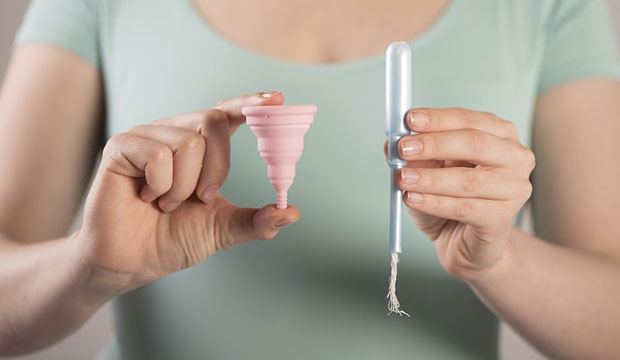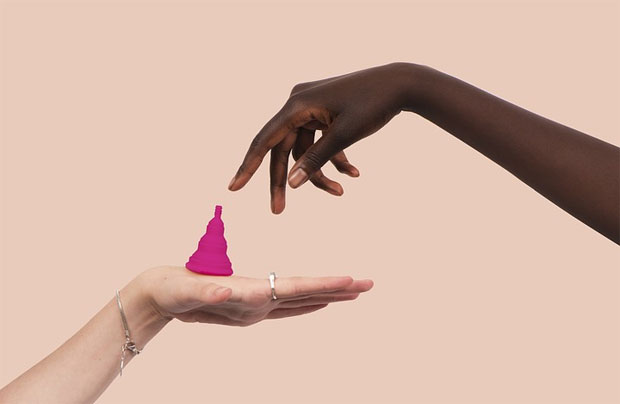Menstrual Cups or Tampons? 5 Things to Consider

Menstrual Cups or Tampons? 5 Things to Consider
You might currently be using tampons, and are perhaps pretty happy with them. Many people are. They’re convenient, easy to use and do a decent job at preventing leaks.
However, there are some hidden costs to tampons that we should consider, including the environment, cost and harm to our health. Let’s take a look at menstrual cups vs tampons in five different categories. The goal is to help you decide which one is best for you. Let’s get to it!
#1: Environmental Impact
Estimates vary, but the average person uses more than 11,000 tampons during a lifetime. This number might be significantly higher if you have a heavy, long or irregular period. Seems like a lot, doesn’t it? Then factor in the packaging, manufacturing costs and transportation of these products too to get the true cost of them.
Particularly bad are the tampons that come with plastic applicators. It’ll take centuries for these to decompose in landfill. Less bad are the tampons without applicators, but even they come wrapped in plastic.
Compare this to a menstrual cup. The top-quality ones made from medical grade silicone can last for around five years, despite some of the companies (the Diva Cup!) saying that they should be replaced every year or two.
If the average person menstruates for 40 years, that’s eight menstrual cups over a lifetime compared to thousands of tampons. It makes a big difference! Imagine the possibilities if every menstruating person in the world had a menstrual cup in their hands?
#2: Cost
Let’s get back to these 11,000+ tampons. They end up costing around $2500 USD. That’s a lot of money just because you have a period.
The best menstrual cups cost around $30 or so, and you’ll need eight of them during your life. That’s $240, or around 10x cheaper than tampons.
Consider making the switch to a menstrual cup from tampons for some serious savings. After all, who doesn’t like having some more money in the bank at the end of the month?
#3: Toxic Chemicals
Here’s something you might not know. It’s that some of the leading tampon brands contain trace amounts of toxic chemicals in them. These toxins are from the pesticides used to grow the cotton, as well as from the manufacturing of them. The bleaching process in particular is quite toxic.
A major part of the problem is that tampons are classified as medical devices by the FDA (food and drug administration in the USA). This means that companies aren’t required to disclose what’s in these products.
A way around this is to make the switch to a menstrual cup in order to have a toxic chemical free period experience.
Just be sure to stick with a top-quality menstrual cup like the Lunette Cup, Diva Cup, Mooncup, Lena Cup, Eva Cup, Saalt Cup, etc. (there are lots of other good ones too). You’ll be assured that you’re getting a product that’s safe to put inside your body for up to a week each month.
You may be tempted by the cheap menstrual cups that you can find on Amazon for around $10. However, they should be avoided because they’re often not made from medical grade materials. They’re also so flimsy that they don’t work very well.
#4: Risk of Toxic Shock Syndrome
The next reason to consider menstrual cups instead of tampons is because of the risk of Toxic Shock Syndrome. Thousands of people get this each year from tampons.
While the risk does exist, in theory, with menstrual cups, only one person to date has gotten TSS from a cup. The risk does appear to be lower than with tampons.
#5: Convenience and Ease of Use
Let’s talk convenience. Tampons are easy to use, and also very easy to dispose of in the trash.What about menstrual cups? You do have to keep them clean, but most people find that this isn’t a big deal and it only takes a few extra minutes during your cycle. You can learn more about that here in this Menstrual Cup Care and Cleaning Guide.
What about using a menstrual cup? They seem kind of big and intimidating!
It’s true, menstrual cups are a lot bigger than tampons and it can seem kind of scary to get started with them. The truth is that there’s a serious learning curve, and it takes most people at least 3-4 cycles to really figure it out. But once you’ve got it, you’ve got it and you’ll probably be happy with it for the rest of your menstruating life!
Menstrual Cups or Tampons: The Takeaway
Which one is right for you? I obviously love menstrual cups, and recommend them to just about anybody. But, they do require a bit more work. The choice is ultimately yours, of course!
This is a Guest Post. About the Author:
Jackie Bolen is a tree-hugging, friend of the Earth who can usually be found on top of a mountain or drinking coffee around Vancouver, Canada. You can find her at:
Jackie Bolen has also published a new book on the topic of menstrual cups: The Ultimate Guide to Menstrual Cups: An Eco-Friendly, Safe, Affordable Alternative to Tampons. You can find it on Amazon.co.uk for Kindle or in Paperback. It’s also available on Amazon.com.





Please let me know if you have any questions, and I’d be happy to answer them!